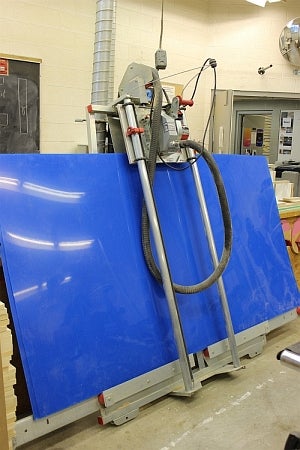Descriptions and Uses
The panel saw is ideal for cutting sheet lumber. It can be used to make large sheets manageable for cutting on the table saw. In addition, heavy sheet lumber cut on the table saw usually requires the aid of an assistant and/or a work support. The panel saw can cross-cut sheet lumber and can be used for ripping.
When cross-cutting with the panel saw, slide your sheet of material on the rollers and use the cross-cut ruler installed on the machine to gauge your size. Loosen the carriage lock holding the saw fast to the guide rail and switch on the saw. Using the handle, pull the saw down until it cuts through the material then switch off the saw. Raise it back up to the top position and lock the saw in place by tightening the carriage lock. Always make sure the saw is allowed to reach top speed before you start your cut. Conversely, allow it to fully stop before you raise it back up to its original position. A saw blade rotating at less than full speed could mar your work.
Ripping can be done from the left or the right, depending on your preference. To rotate the motor, pull out the indexing pin with one hand and rotate the saw with the other hand. Lock the indexing pin into one of the pre-set holes. Loosen the carriage lock on the rail and set the saw in place following the measure on the rip ruler. Tighten the carriage lock securely. Start the motor. Place the workpiece on rollers and slowly move the workpiece through the saw in the direction of the feed arrow on the saw motor. Avoid placing your hands under the saw carriage. Do not look directly down the line of cut. After the cut is completed, turn off the tool and allow it to completely stop. Pull the finished workpiece and the scrap away from the tool.
Further considerations
- Do not drop the workpiece on the rollers: This may knock the rollers out of alignment.
- Verify location of on/off switch and/or emergency power disconnect.
- When making cuts less than 1 inch, the chatter guard located inside the blade guard must be on the workpiece and not the cut-off piece. Otherwise, jamming can occur.
- If the saw jams, turn off the tool and wait for the saw to stop completely. Back the saw out of the cut.
- Ensure that the table is clear of materials, tools, and debris.
Tip
The roller extensions are below your line of site. Be aware of their location to avoid tripping when loading the saw and/or ripping material.
Caution
- Eye protection is mandatory
- Ear protection is required for prolonged use.
- A dust mask is recommended for plywood and particleboard and required for MDF and certain toxic woods.
- Only operators trained in the safe operation of a panel saw are allowed to use this tool.
- Never start the machine with the blade touching the workpiece.
